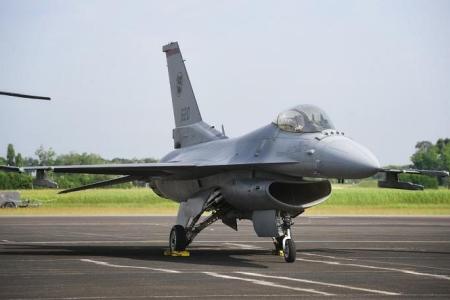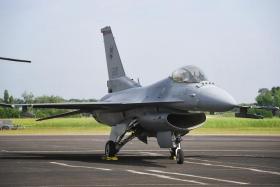RSAF to step up checks on F-16 component that malfunctioned and caused May 8 crash
The F-16 component responsible for the May 8 crash at Tengah Air Base will be subjected to additional routine maintenance checks to ensure that any early signs of degradation are detected.
The pitch rate gyroscopes will also be replaced pre-emptively, even before they reach a stage of advanced degradation, said the Ministry of Defence (Mindef) in a statement on June 19.
Pitch rate gyroscopes are components that a flight control computer uses to control an aircraft.
All F-16 fighter jets are fitted with them.
The statement laid out the conclusion of the investigations, which were led by the Republic of Singapore Air Force (RSAF) and supported by F-16 manufacturer Lockheed Martin and the Transport Safety Investigation Bureau.
The pitch rate gyroscopes in the F-16C single-seat fighter jet had malfunctioned on the day of the crash, with checks by the pilot before take-off showing that all was fine.
During take-off, Mindef said, two of the four devices in the aircraft sent erroneous input to the flight control computer, which accepted it.
Consequently, input from the two other working gyroscopes was rejected, resulting in the computer using the wrong input when manoeuvring the jet. This led to the pilot losing control of the jet.
Mr Tay Siew Liong, chief engineering and technology officer for defence aerospace at ST Engineering, said flight control for an F-16 relies on a “majority decides” basis when it comes to getting input from a set of three active gyroscopes.
“So when the second and third gyroscopes failed at the same time, yet had readings that were close to each other, the (input of the) first gyroscope will be regarded as faulty and discarded,” he said.
“At this point, the standby fourth gyroscope will be active... (its input) also got discarded, leaving the two faulty ones to provide the wrong input.”
Describing simultaneous failures as a “very rare occurrence”, Mr Tay – who has worked on F-16s previously – added that if the gyroscopes had failed one after another, the flight control computer would have discarded the information accordingly, and the correct data would have been used.
Citing Lockheed Martin, Mindef said the gyroscope malfunction is a rare occurrence, and the first such failure reported to the manufacturer since F-16s first flew in 1974.
The crashed F-16C had been maintained in line with established protocols, and the RSAF had conducted the compulsory maintenance inspections, said the ministry.
It added that Lockheed Martin does not stipulate any maintenance for the pitch rate gyroscopes in F-16 aircraft.
Prior to F-16 flights resuming on May 21, each F-16 in the RSAF had its gyroscopes checked and cleared as well.
Mindef said there are about 3,100 F-16s operating in 25 countries, clocking more than 19 million flight hours, and expressed its confidence in the capability and reliability of the fighter jet.
The May 8 crash was the fourth involving an RSAF F-16 since the aircraft entered service in the late 1980s.
Get The New Paper on your phone with the free TNP app. Download from the Apple App Store or Google Play Store now


